Ukraine Conflict Monitor - 24 June – 30 June 2023 (Weekly update)
Situational report 24 June – 30 June 2023
BLUF: The Ukrainian Armed Forces continued conducting offensive operations in southern parts of the country and around Bakhmut. Last week, these attacks delivered limited territorial gains in the Bakhmut axis, near Velyka Novosilka and in the Kherson Oblast. However, these tactical victories do not herald a wider Ukrainian breakthrough as Kyiv’s forces are unable to generate sufficiently high momentum. Battles continue to have an attritional character.
Key takeaways from last week’s developments:
Over the past seven days, Ukrainians continued ground attacks across the main axes in the Zaporizhihia and Donetsk Oblasts;
These attacks delivered minimal gains that resulted in one village captured and two bridgeheads established, one south of Bakhmut and the other south of Kherson; Ukrainian forward movement last week was hard-fought as no significant momentum was built up to propel further gains; In this context, Russian defensive lines did not break while Russian defensive operations were largely successful;
No changes were reported in the Kharkiv Oblast, where despite limited ground attacks, the frontline remained stable;
Likewise, no frontline changes were reported in the Luhansk Oblast; Russian artillery strikes decreased over the past seven days, which may suggest a reduction in Russian ground activities; A pro-Russian source claimed on Friday that Ukraine conducted a counterattack in the Kreminna area;
Russians made no gains in the Donetsk Oblast, although they launched several ground attacks around Bakhmut; However, it was Ukrainians who captured a bridgehead over the Siversky Donets-Donbas Canal in Kurdyumivka, some ten kilometres south of Bakhmut;
Ukrainians captured Rivnopil, around 10 km southwest of Velyka Novosilka, and extended attacks towards Pryyutne;
No frontline changes were reported in the Orikhiv axis, but Ukrainians maintained overall pressure towards Robotyne;
Ukrainian units also successfully crossed the Dnipro River and established a foothold in Dachi, near the Antonovskyi Bridge, south of Kherson; This allowed them to extend attacks towards Oleshky;
Over the past seven days, Russians launched one mass missile strike on Ukraine, which included 40 Kh-101/Kh-555 cruise missiles; Ukrainian Air Force Command claimed to have shot down all missiles;
Executive summary
Over the past seven days, the Ukrainian Armed Forces (UAF) continued conducting offensive operations from the Kherson Oblast in the south, through Zaporizhihia and Donetsk Oblasts, to areas north of Bakhmut. Although the frontline is more than 1,000 kilometres long, in reality, and taken together, most battles occurred along a 120km wide frontline.
Last week we also saw a continued deprioritisation of the Kharkiv and Luhansk direction. While it is not surprising that the situation in the former did not change, a decrease in Russian artillery attacks in the Luhansk Oblast is noteworthy. Whether this reduction is short-lived or heralds a broader change in Russian ground attacks in the Kupyansk-Dibrova line remains to be seen. But the key thing to note is that despite Ukrainian officials’ pronouncements about a Russian offensive in the Kreminna area from two weeks ago, we noticed no major changes in the Russian posture since then, neither did we confirm any Russian territorial gains. Even if initially there was an uptick in the scale of Russian attacks and operations, it was brief and delivered no frontline changes. Likewise, the tempo of Russian ground attacks on Bilohorivka also declined as previous attempts to storm the city proved futile. As such, Russia is inherently unable to progress west from its deployment areas along the Kreminna-Lysychansk line towards Lyman, let alone towards Slovyansk in the Donetsk Oblast. This inability will continue to hinder Moscow’s plans to capture the remaining part of the Donetsk Oblast and thus fulfil the main objective of the second phase of this war. From the Russian perspective, this goal has been pursued since late APR22 and delivered modest gains at high manpower and equipment losses. Consequently, we will reiterate last week’s point that the Russian ability to launch any large-scale attacks to deliver large territorial gains remained minimal.
On the other hand, Ukrainians launched a third counteroffensive in 10 months, which by all means highlights their ability to create new units and regenerate these deployed. The sustainability of these forces will be essential over the medium term (until October). Indeed, Ukrainian progress in the Southern axis has been limited. Last week, Ukrainians captured one village in the Velyka Novosilka axis, and no progress was made near Orikhiv. A similar situation occurred two weeks ago when P’yatykhatky were captured, but back then, Ukrainians reportedly continued to inflict heavy losses on the Russian armoured fleet and artillery systems. Last week marked a change in this these operations as well. According to the Ukrainian General Staff (UGS), over the past seven days, Russians lost 24 tanks (compared to 91 two weeks ago), 65 armoured combat vehicles (ACVs) (167), and 142 artillery pieces (249). The drop is significant. The next seven days will show whether this is the beginning of a longer trend or a temporary decrease in ground attacks and artillery strikes.
Despite this, Ukrainians achieved two other important tactical successes. Firstly, they crossed the Siversky Donets-Donbas Canal and established a foothold in Kurdyumivka. Some Ukrainian sources claimed that the Russian presence in Klishchiivka will suffer as a result, which will have an impact on the entire Bakhmut southern flank. Secondly, as the Dnipro River receded, Ukrainians captured Dachi and extended attacks towards Oleshky. The control over the latter village is key for further operations as it opens up possible routes of advance in all directions (south, east, and west), which also includes the shortest route to Crimea. Nevertheless, we presently assess that operations around Dnipro have a fixing character and seek to tie up Russian forces in the southern parts of the oblast and perhaps redirect previously deployed units from Zaporizhihia to Kherson. We assess that conducting the river crossing operation is still too risky, while the terrain is too muddy to deploy armoured vehicles across Dnipro.
On Thursday, Wall Street Journal reported that the US administration is edging closer to approving the delivery of Army Tactical Missile Systems (ATACMS) to Ukraine. It has a reported range of up to 300 km (190 miles) and can increase Ukrainian strike capability to hit targets well behind the frontline. However, ATACMS is no Wunderwaffe, and its impact on the battlefield may be limited. Following the initial deployment of HIMARS to Ukraine, many Russian storage facilities and concentration areas went up in flames. It took Moscow a couple of months to disperse its presence, forward logistics bases, and, in general, adjust to the HIMARS threat. The impact of Storm Shadow (reported 250 km (155 miles) range) is much more limited. Only one big ammunition depot was hit, which confirms that Russians adapted to Ukraine’s precision strike capability. It is not at all clear that ATACMS will significantly impact the Russian ability to sustain their forces, especially if the number of missiles to be delivered is limited. Likewise, it is also likely that Washington will ask Kyiv not to use ATACMS on targets inside of Russia (probably Crimea excluded), which will further limit its impact. Nevertheless, from our point of view, the discussions about the delivery of new capabilities to Ukraine again occur too late. To prepare the battlefield for the counteroffensive, Ukraine should have received long-range precision strike capability months ago to have time to gradually wear the Russians and their logistics system down. Deploying it now when Russians have adapted risks limited impact and increased pressure on Kyiv to deliver territorial gains faster. The same goes for cluster munitions, which could have been used during the opening days of the counteroffensive. These discussions also highlight one more aspect of Western support. In some aspects, the West prefers to hand it over slowly to see the impact on the battlefield and how the Russians will respond/adjust. We are unsure whether this is a coherent strategy allowing Ukraine to push Russians out quickly.
The past week was the most successful for Ukraine across all fronts since the early days of the counteroffensive. Ukrainians pressured Russians across multiple axes in different directions. Let’s see whether Kyiv will be able to gather and maintain momentum over the next week.
Ukraine battle map
Please click here to access our interactive map and click here to access the archive.
The situation at selected axes and directions
Kharkiv direction
As expected, last week delivered no changes in the Kharkiv Oblast. Russian units continued ground attacks near Berestove, Hryanykivka, Masyutivka, Synkivka and Krohmalne, but they delivered no frontline shifts. As such, the overall situation in this part of Ukraine remains stable.
At the same time, Russians launched no ground attacks near the state border into Ukraine.
That said, and this was expected as well, Russians continued striking civilian infrastructure. Last week, among others, they hit struck Kupyansk, Vovchansk, Kolisnykivka, Hlushkivka, Udy, Veterynarne, Kozacha Lopan, Staritsa, Ohirtseve, Dvorichna, Zapadne and Masyutivka.
According to the Russian Ministry of Defence (MoD), Russian units conducted multiple attacks on Ukrainian positions in the region over the past seven days. Su-34 medium-range fighter-bomber/strike aircraft hit deployment points of the 103rd Territorial Defence Brigade near Kivsharivka. Ka-52 and Mi-28 attack helicopters and Su-25 close air support aircraft carried out multiple air strikes on concentration areas of the 14th Mechanised Brigade and unspecified territorial defence units. Ukrainian sabotage and reconnaissance group from the same brigade was interdicted by artillery near Novoselivkse.
The Russian artillery disrupted several Ukrainian attempts to rotate units at forward positions near Kyslivka, Vilshana, Novoselivske and Novomlynsk and Krasne Pershe. Based on these Russian reports, one can conclude that particular focus was placed on the positions of the 103rd TD and 14th Mechanised Brigades. However, we assess that this is not a prelude to a larger offensive action in this direction. The intensity of Russian attacks (ground and air) did not change compared to previous weeks.
Luhansk direction
Likewise, the overall situation in the Luhansk Oblast did not change. To recall, a week ago, multiple Ukrainian sources claimed Russians went into the offensive in the Lyman-Kreminna axis. The expectation among many observers was that Russians would capture some territory. However, we have not been able to independently conclude that any frontline shifts occurred. While some territory may have changed hands, Russians made no significant gains. By saying “major gains”, we mean capturing one village or more.
We need to highlight one more thing. As noted in previous UCM issues, according to Serhiy Cherevaty, the spokesperson for the Ukrainian Eastern Group, the Kupyansk-Lyman axis, for many weeks, was the heaviest shelled region in Ukraine, even at the apex of the battle for Bakhmut. However, the intensity of Russian artillery strikes was visibly reduced over the past seven days. For instance, on 12 and 13JUN, Russians fired 505 and 428 times, respectively, on Ukrainian targets. Although the number was still high on 25JUN when it reached 477 strikes, subsequent days delivered 344, 372, and 449 hits. The drop appears short-lived, but it may suggest access to ammunition issues if it occurs again.
Last week, Russians conducted at least 25 ground attacks and at least 20 air strikes, although we assess that these numbers are underreported.
But, returning to the frontline, the situation in the Svatove area remained stable, and no Russian attacks were recorded near Stelmakhivka.
No changes occurred near Novoselivkse and Kuzemivka. The same goes for Makiivka, Ploshchanka and Chervonopopivka areas. Neither Russian nor Ukrainian sources reported changes near Terny, Yampolivka, Torske and Nevske.
As stated above, no changes occurred in the Kreminna area. Battles were ongoing in the Serebryansky forest, where Russians launched some localised ground attacks. However, they delivered no changes. On Friday evening, a pro-Russian source stated that Ukrainians launched a counterattack in this sector involving six brigades.
No shifts were also reported in the Bilohorivka area, where Russian operations appeared to have been subdued, especially compared to the prior two-three weeks. Russians either paused attacks to regroup and/or reinforce or decided to cease offensive actions due to a lack of progress and exhaustion of their attacking potential.
That said, we should note that the Russian MoD portrays a slightly different picture of the tactical situation in the southern part of the front. Firstly, on Wednesday, Ukrainian 21st and 42nd UAF Mechanised Brigades (likely elements) launched ground attacks on Russian positions to regain lost ground (unclear where). Heavy artillery fire repelled these attempts. Russians also reportedly hit multiple times with artillery deployment points of 42nd, 63rd and 67th Mechanised Brigades in the Torske area and the Serebryansky forest.
In the meantime, Russian Su-34s hit Ukrainian units near Nevske, Novolobivka and Dibrova.
(The data on Russian fortifications comes from Brady Africk).
Donetsk Oblast Direction
Ukrainians made limited gains in the Donetsk Oblast over the past seven days. There was a visible increase in their activities south of Bakhmut, where they managed to cross the Siversky Donets-Donbas Canal.
No changes occurred near Spirne, Verkhnokamyasnke, Vyimka and Ivano Darivka. It does not mean, however, that offensive operations in these sectors did not occur. On Tuesday, Vadym Astafiev, a Russian South Group of Forces Spokesperson, said that elements of the 56th Motortised Infantry Brigade launched attacks near Vasylivka and the 57th Mechanised Infantry Brigade near Berkhivka. In addition, a Ukrainian SOF unit attempted to conduct a reconnaissance mission near Verkhn’okam’yans’ke. All attacks were repelled, the MoD claimed.
Also on Monday and Tuesday, Russians reportedly attacked Ukrainian positions near Vesele and Rozdolivka. Neither Russian nor Ukrainian sources reported changes near Vasiukivka and Fedorivka.
According to a Russian journalist, Russian troops tried to counterattack near Berkhivka but were unsuccessful. Moving further south, according to Anna Malyar, the deputy Ukrainian Minister of Defence, the Ukrainian offensive actions in the Bakhmut sector had been going on since the weekend, especially near Orikhovo-Vasylivka, Bakhmut, Bohdanivka, Yahidne, Klishchiivka and Kurdyumivka. Ukrainian forces were advancing on the flanks every day. She added that ” the UAF advanced between one and two kilometres” in each direction. On Thursday, both Ukrainian and Russian sources stated that the Ukrainian 30th Mechanised Brigade partially succeeded on the road from Slovyasnk near Zaliznyanske. So far, it is unclear what this development involved.
According to a Russian source, although Ukrainian infantry broke through Russian positions near Sakko and Vantsetti, they were “destroyed”.
According to a Ukrainian soldier, who fights in the Bakhmut direction, the UAF made progress near Klishchiivka, Yahidne, Berkhivka, Kurduimivka and Ozaryanivka. He also claimed that the UAF advanced in Bakhmut City. Near Orikhovo-Vasylivka, the UAF also continued to advance too. However, a soldier failed to provide any evidence to confirm his claims. Russian sources did not report any changes.
The same source claimed on Tuesday that Ukrainians were also progressing in Bakhmut. On Thursday, another Ukrainian serviceman claimed that Russian troops were pushed out of Voiniv Internatsionalistiv Street.
The uptick in Ukrainian activity was particularly visible in sectors south of Bakhmut. On Monday, a Ukrainian source stated that Ukrainians cleared the area along the Siverskyi Donets-Donbas Canal southwest of Ozaryanivka. It is possible that the source confused Ozaryanivka with Kurdyumivka. In the latter, Ukrainians crossed the canal on Tuesday (although likely earlier). The commander of Ukrainian Ground Forces, General Oleksandr Syrskyi, confirmed this development, adding that personnel of the 1st company of the 1st mechanised battalion of the 3rd Assault Brigade destroyed the Russian third battalion of the 57th Guards Motor Rifle Brigade in the process.
The forward movement reportedly continued since Tuesday, but so far, no evidence has been provided to confirm Ukrainian advances. A Ukrainian soldier was nevertheless confident that the fall of Klishchiivka was only a matter of time (battles for the village were reportedly ongoing on Thursday) as many Russian servicemen surrendered. However, we assess that such statements are overly optimistic.
No further frontline changes occurred in other parts of the front in the Donetsk Oblast.
That said, on Monday, Ukrainian bloggers noted that Russians launched an attack on Ukrainian positions along the Vesele – Kruta Balka line, culminating their attacks, which had already been ongoing for several days. Despite this, Ukrainian and Russian sources reported no frontline changes in this sector.
Neither Russian nor Ukrainian sources reported any changes near Krasnohorivka, Novokalynove, Vesele, Keramik, Berdychi, Stepove, Kamyanka and Kruta Balka.
The situation near Avdiivka remained unchanged too. Russian attacks were visibly reduced, confirming our previous assessments of limited Russian offensive potential in the area.
On Wednesday, Russians resumed ground attacks towards Pervomaiske, but we understand they were limited in size and delivered no gains.
Neither Russian nor Ukrainian sources reported changes near Tonenke, Severne, Vodyane and Nevelske.
Expectedly, Russian attacks in Marinka had no impact on the frontline. They again launched several ground attacks supported by artillery, but overall, they made no progress.
Lastly, we removed the Vuhledar area from the Southern Direction last week. Our decision was correct. Over the past week, activities in this sector were further reduced and delivered no frontline changes.
On Monday, Malyar said that between 19-25JUN, about 250 combat engagements occurred near Lyman, Bakhmut, Avdiivka and Mariinka. She also added that Russians conducted 6,457 artillery attacks in the eastern parts of the country and launched 315,006 munitions. Please note that we do not believe she was talking only about artillery munitions but various rounds in general.
She stated that the number of attacks increased compared to the previous week.
Southern Ukraine direction
Last week delivered minimal Ukrainian gains in southern parts of the country. The tempo of Ukrainian attacks was high. There is no evidence that Ukrainians were pausing their activities or still conducting probing attacks. On Monday, Malyar provided some data on the progress of the counteroffensive. Firstly, she said that Ukrainians had liberated 130 sq km of land since early June. She said that last week (19-25JUN), Russians conducted 148 ground attacks and launched 3,861 artillery attacks in southern Ukraine. Ukrainian units performed 8,783 firing missions during the same period. Therefore, she suggests that Ukrainians enjoy superiority in artillery fires. Lastly, she said that the casualty ratio stands at 7:1 (Russians vs Ukrainians), a claim which, we believe, is exaggerated.
On Thursday, she said that Russians were constantly deploying reserves to the frontline and that Ukrainians progressed 1,300 m in the Berdyansk direction.
Velyka Novosilka axis
Firstly, on Monday, Ukrainians liberated Rivnopil. Russians pulled back to hold the Pryyutne– Staromaiors’ke – Novodonetske – Pavlivka line. At the same time, they launched multiple counterattacks to recapture Rivnopil, but these attempts proved futile.
Interestingly, a pro-Russian source said that following the liberation of Rivnopil, Ukrainians deployed a tank platoon of the 31st Mechanised Brigade, presumably south of the settlement. Therefore, it seems that the number of Russian and Ukrainian units committed to combat is relatively small. Russian counterattacks could also be small if Ukrainians believed a tank platoon was sufficient to form the first line of defence.
It is also important to note that after the capture of Rivnopil, the Ukrainian 31st Mechanised, 36th Marine, and 128th Territorial Defence Brigades carried on pushing south towards Pryyutne. Despite artillery strikes, Ukrainians were determined to continue attacks towards Stepove – Pryyutne. Malyar also confirmed on Thursday sustained attempts in the Rivnopil – Volodyne direction.
Orikhiv axis
The past seven days delivered no frontline changes in this axis. Following the loss of Piatykhatky, Russians launched multiple counterattacks to recover control of the village. The latest reports indicate the village in no man’s land, although the loss of Ukrainian control there was not independently confirmed.
Ukrainians also tried to attack towards Rabotyne, where Ukrainians concentrated the bulk of their efforts. Yet, we understand that no/little progress was made.
Heavy rainfall hindered the movement of heavy vehicles, which may partly explain a decrease in Ukrainian activity. The pro-Ukrainian source stated that the Ukrainian 117th Artillery Brigade of the 10th Army Corps was deployed to Luk’yanivs’ke, Novoyakovlivka and Pavlivka to support Ukrainian ground attacks in the Orikhiv axis.
Kherson direction and Crimea
Undoubtedly, the most important event occurred on Sunday when Ukrainian forces crossed the Antonivskyi Bridge and established a foothold near Dachi along the Antonivskyi Bridge in the direction of Oleshky.
Not only did Russian counterattacks fail to deliver any successes, but Ukrainians gradually progressed throughout the week. As early as Tuesday, the Ukrainian source said that Russians were knocked out of their positions north of Oleshky. By Friday, Ukrainians managed to consolidate their gains in this area.
If we go back to our Substack post on the military situation in the Kherson Oblast after the collapse of the Nova Kakhovka Dam, we will see that the control of Oleshky (KEY AREA 2) is critical for further advances inland. It allows moving forces east, west, and south and opens up the shortest route to Crimea.
But to achieve this objective, Ukrainians must deploy heavy armour to sustain their operations. Although the ground appears dry on the surface, it is still muddy inside and heavy equipment would undoubtedly get stuck. As such, some river crossing or other engineering equipment will be needed to move forces across.
In the meantime, Russians conduct daily artillery and air strikes on Ukrainian positions in Dachi to prevent their forward movement.
On Tuesday, Natalia Humeniuk, the spokesperson for the Ukrainian Command South, said that operations were going according to plan and that the information silence should be observed during combat operations.
In the meantime, on Tuesday, Russians reported destroyed railway tracks in the Kirov district in Crimea. This event derailed at least one cargo platform. On the same day, Ukrainians launched a UAV attack on Dzhankoy, but the drone was reportedly intercepted.
Summary of losses
According to the Russian Ministry of Defence, since the start of the war, Ukraine has lost 444 aircraft (0), 240 helicopters (0), 4,833 UAVs (+82), 426 anti-aircraft missile systems (launchers?)(0), 10,413 tanks and other armoured combat vehicles (+116), 1,134 MLRS launchers (+5), 5,281 field artillery guns and mortars (+77), as well as 11,292 units of special military vehicles (+166).
According to the Ukrainian General Staff, Russia lost (eliminated) 228,340 personnel (+5,010), 4,041 tanks (+24), 7,863 armoured combat vehicles (+65), 4,127 artillery systems (+142) and 630 MLR systems (+13), 389 anti-aircraft systems (+10), 315 aircraft (+1) and 308 helicopters (+1), and 3,519 UAVs (+72), 6,785 vehicles and fuel tanks (+77), 1,214 cruise missiles (+47), 18 warships and boats (0) and 569 special vehicles (+24).
According to the UGS, the scale of Russian losses significantly decreased across the board compared to two weeks ago. This is particularly visible in the number of tank losses (24 vs 91), ACVs (65 vs 167), and artillery systems (142 vs 249). This appears to indicate a decrease in the intensity of Ukrainian attacks. The 7-day average in the number of destroyed Russian artillery systems peaked on Tuesday at 28. Since then, however, it decreased to 20 on Friday; hence the reduction is substantial. In terms of daily figures, on 23JUN, Ukrainians claimed to have destroyed 44 Russian artillery systems. On 28JUN this figure dropped to six, the lowest reported number since 30APR. Although this appears to be an extreme end of the spectrum, the data provided by the UGS clearly shows a downward trend last week across all platforms.
(Numbers in parentheses denote a weekly change)
Russian attacks on Ukraine
The past week delivered one mass employment of Russian cruise missiles. On Saturday, ten Russian Tu-95 strategic bomber aircraft fired 40 Kh-101/Kh-555 cruise missiles when operating over the Caspian Sea. At the same time, eight Tu-22M3s fired nine Kh-22 long-range anti-ship missiles in a multivector attack from north, south, and east. Two Kalibr cruise missiles were also launched from the Black Sea.
The Ukrainian Air Force Command claims to have shot down all Kh-101s/Kh-555s and one Kalibr. No information was released on Kh-55 interceptions, which suggests they hit targets across Ukraine. Kyiv does not possess the capability to intercept Kh-55 successfully due to its high velocity. It was the largest attack since late May.
The Shahed 131/136 attacks were also limited. The largest attack was reported on Friday when Russians launched 13 dones. Ukrainians reportedly intercepted ten. In total, over the past seven days, Russians launched at least 29 Shaheds, compared to the previous week’s of
Lastly, according to the UGS data on the scale of Russian attacks, the past seven days were relatively stable. There was an increase in the MLRS attacks, especially in the latter half of the week, but a mixed use of air power.
Outlook for the week of 1JUL-7JUL
In assessing the probability or likelihood of certain events, we use a set of terms proposed by the US Intelligence Community.
To introduce more accountability to our forecasts, each weekly update assesses how correct (or incorrect) our predictions were. Please also remember that while we try to remain as objective as possible regarding our performance, the reader will ultimately have to decide how (in)accurate we have been.
Previous forecast
“Despite the reported increase in Russian offensive activities, we expect no major changes in the Kharkiv Oblast. It is unlikely that Russians will capture one village or more over the next seven days in the region.” This assessment was correct.
Score: 1/1
“The same goes for the Luhansk Oblast, including Kreminna and Bilohorivka areas. Russians will continue to attack Ukrainian positions, especially west of Dibrova and near Bilohorivka, where the centres of Russian focus are. But, whereas they can capture some territory, we consider it unlikely they will capture one village or more over the next seven days.” Russians indeed made no progress in the region last week.
Score: 1/1
“Regarding the Donetsk Oblast, let’s first focus on Russian operations. 1) Moscow will continue conducting ground attacks across the region, focusing on Avdiivka, Mariinka and areas surrounding Bakhmut. Yet, we assess it unlikely that they will manage to capture one village or more, although some gains in inhabited areas are possible. Regarding Ukrainians, 2) Kyiv’s operations will focus on attacks on the northern Bakhmut flank. But, unless the Ukrainian presence is reinforced, Ukrainians are unlikely to make confirmed gains.” While we correctly anticipated a lack of Russian progress, we were incorrect about Ukrainian gains. Although we only expected Ukrainian gains after reinforcements, no information suggests such reinforcements occurred.
Score: 0.5/1
“Moving onto the southern direction, it is impossible to predict Ukrainian gains or the course of the counteroffensive in general. But given that Ukrainian progress appears to have stalled, we assess that it is unlikely they will capture more than one village next week.” This prognosis was incorrect as Ukrainians captured Rinvopil.
Score: 0/1
“We might be seeing the first signs of a shifting situation in the Kherson Oblast. Russian artillery units returned to their original positions after the collapse of the Nova Kakhovka dam, and the intensity of artillery fire also returned to pre-6JUN levels. But more importantly, the reported movement of Ukrainian units towards the region could indicate that Kyiv may also increase the scope of their attacks. In general, it is unlikely that the situation in the region will change over the next seven days. Still, we will keep a close eye on the deployment of Ukrainian forces to the Kherson Oblast and look for any signs indicating shifts in posture.” While we correctly forecasted a change in the region, we did not appreciate how quickly events would unfold.
Score: 0/1
Final score: 2.5/5 (50%)
The forecast for the week of 1-7JUL
As expected, we continue to anticipate no changes in the Kharkiv Oblast. Russian ground attacks are highly unlikely to deliver any major frontline changes (capture one village or more). Artillery attacks on civilian targets will almost certainly continue.
The same goes for the Luhansk Oblast, including Kreminna and Bilohorivka areas. Despite official Ukrainian pronouncements about Russian attacks in the region, we assess that it is unlikely that Russians will capture one village or more.
When it comes to the Donetsk Oblast, let’s divide the forecast into possible Russian and Ukrainian courses of action. 1) Based on last week’s performance and troop deployments, it is highly unlikely that Russians will capture one village or more in the entire region. 2) We assess that Ukrainians are likely to liberate some territory, especially south of Bakhmut and especially if they maintain the foothold over the Seversky Donetsk-Donbas Canal. 3) There is roughly even chance that Ukrainians will capture one village or more.
Moving onto the southern axis, we continue having difficulty forecasting Ukrainian operations in the region. The reported deployment of a new artillery brigade to the Orikhiv axis could herald more progress. Ukrainians also continue to push in the Velyka Novosilka. In general, we assess that there is a roughly even chance that Ukrainians will capture a village over the next seven days.
We now expect Ukrainians to continue in their attempts to push south of the Dnipro River in the Kherson Oblast. They will likely capture some ground around Oleshky.






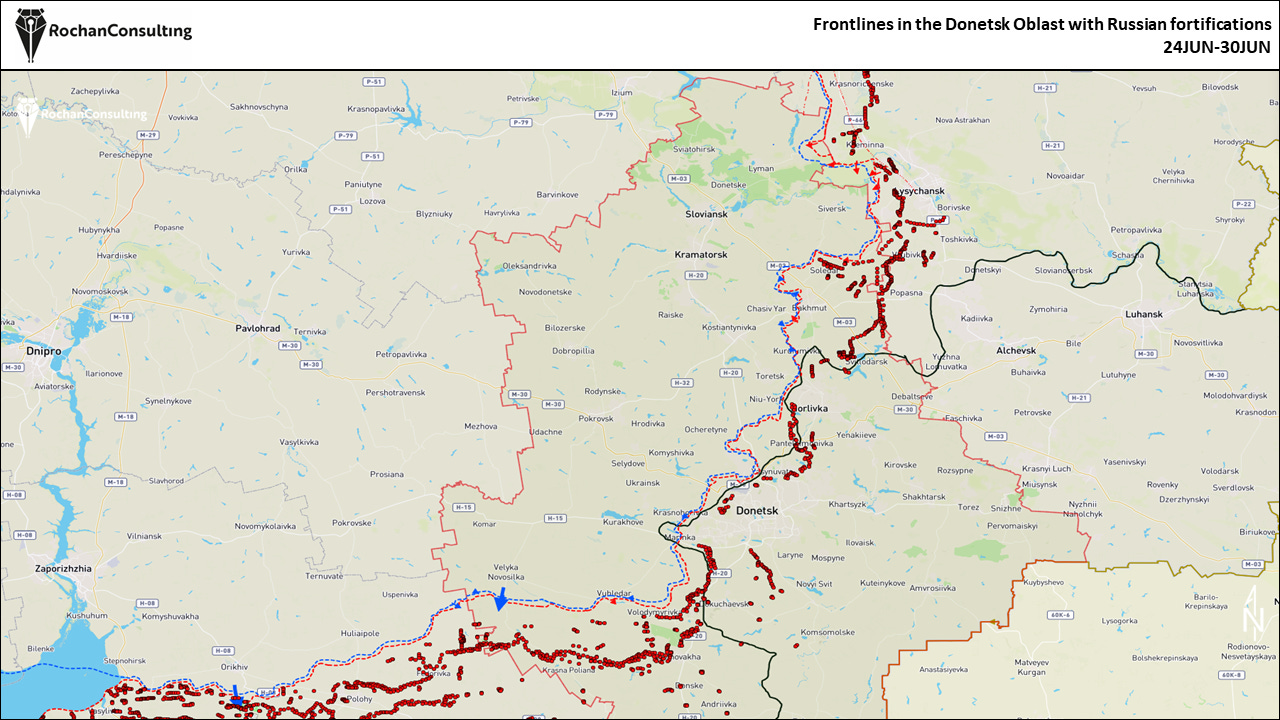
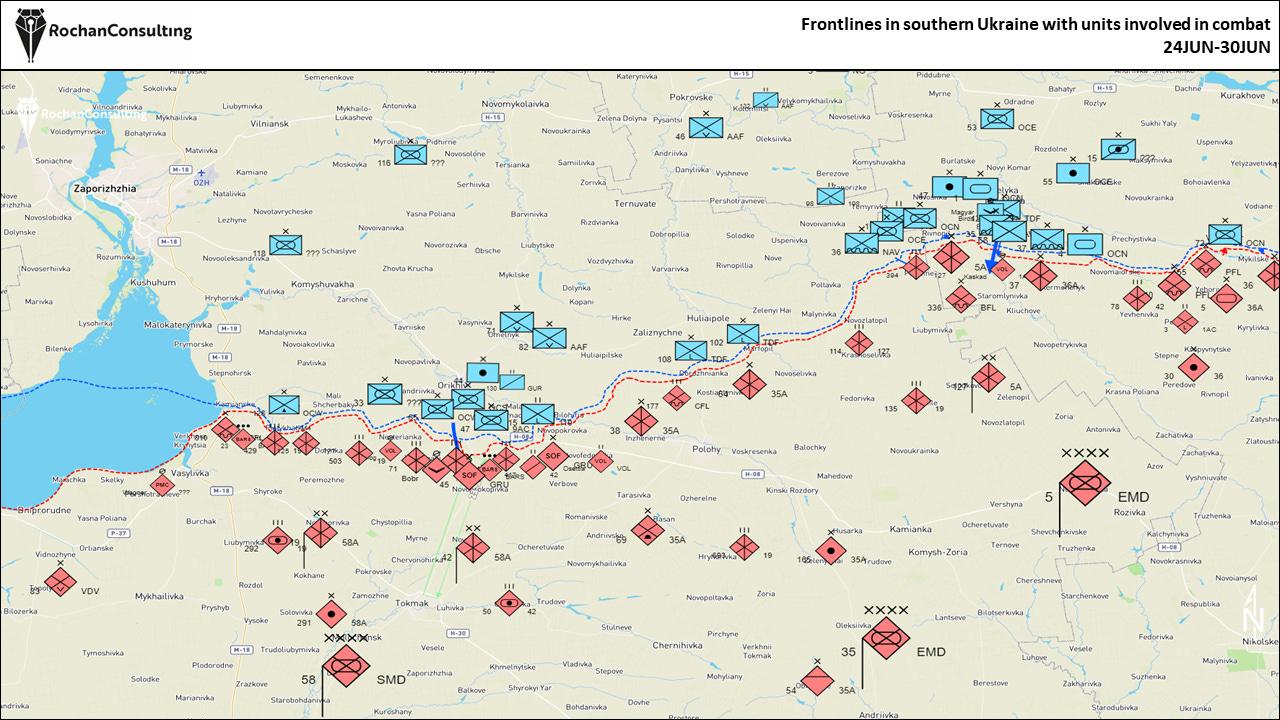
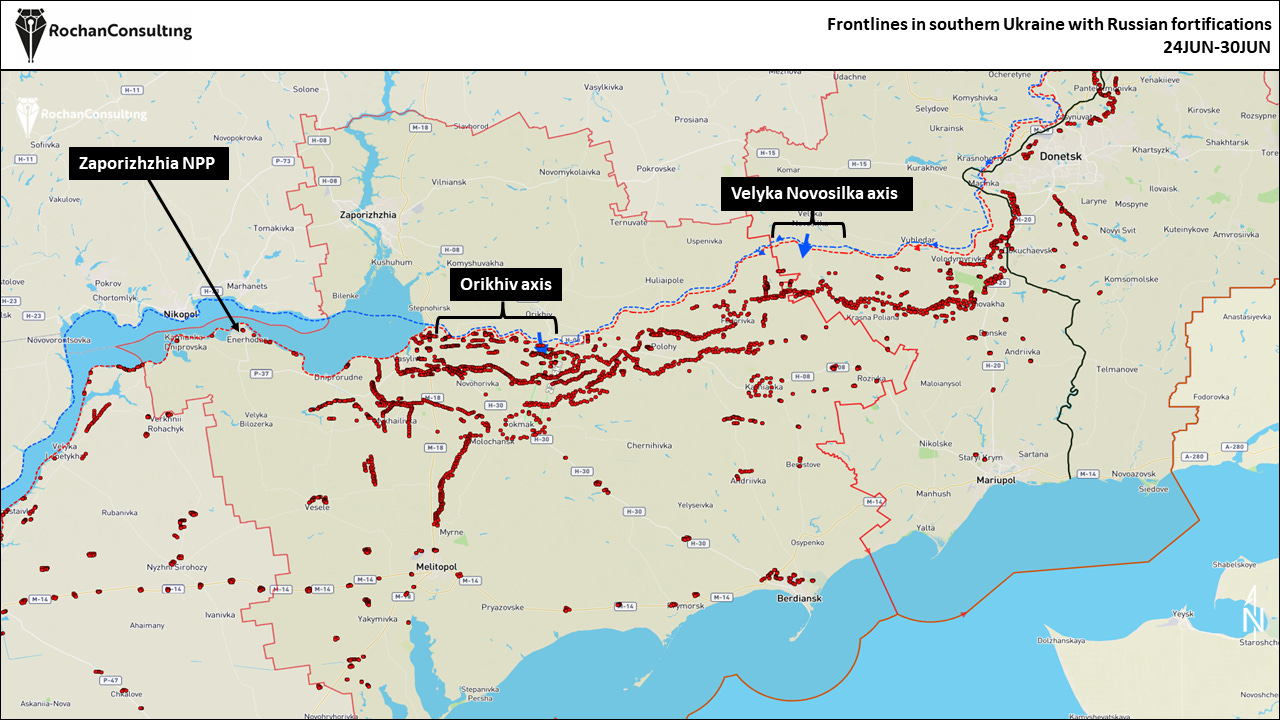

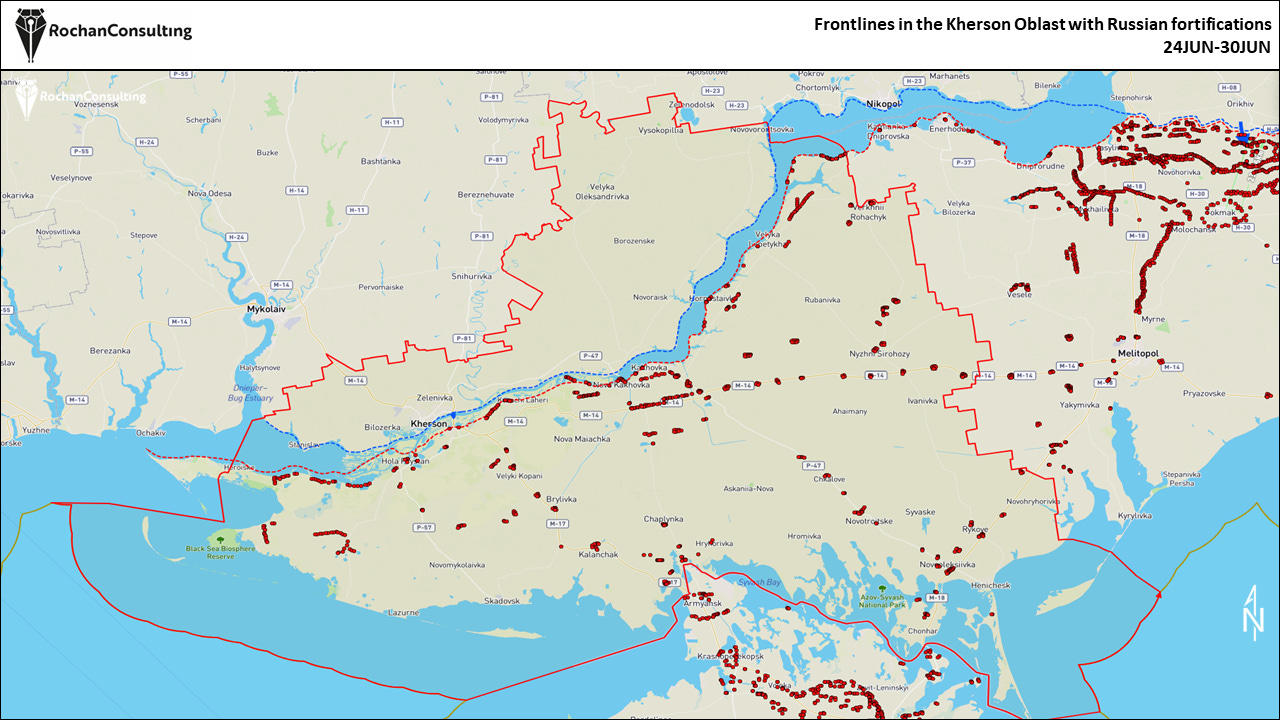
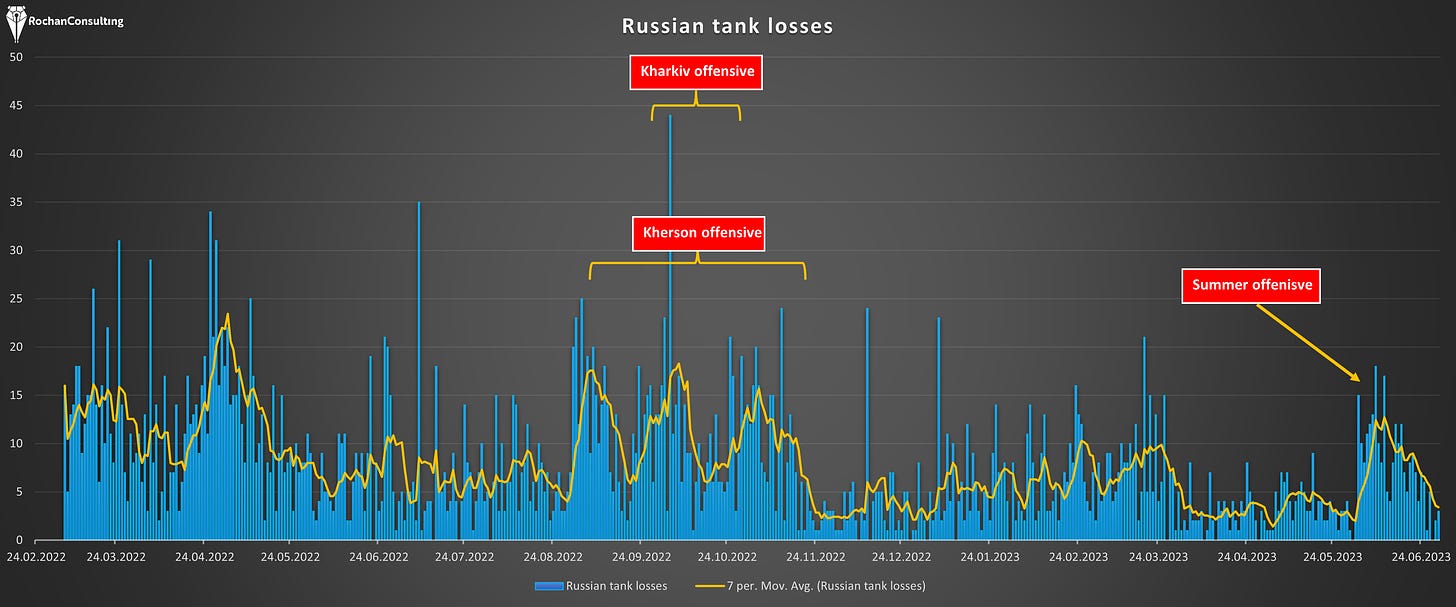
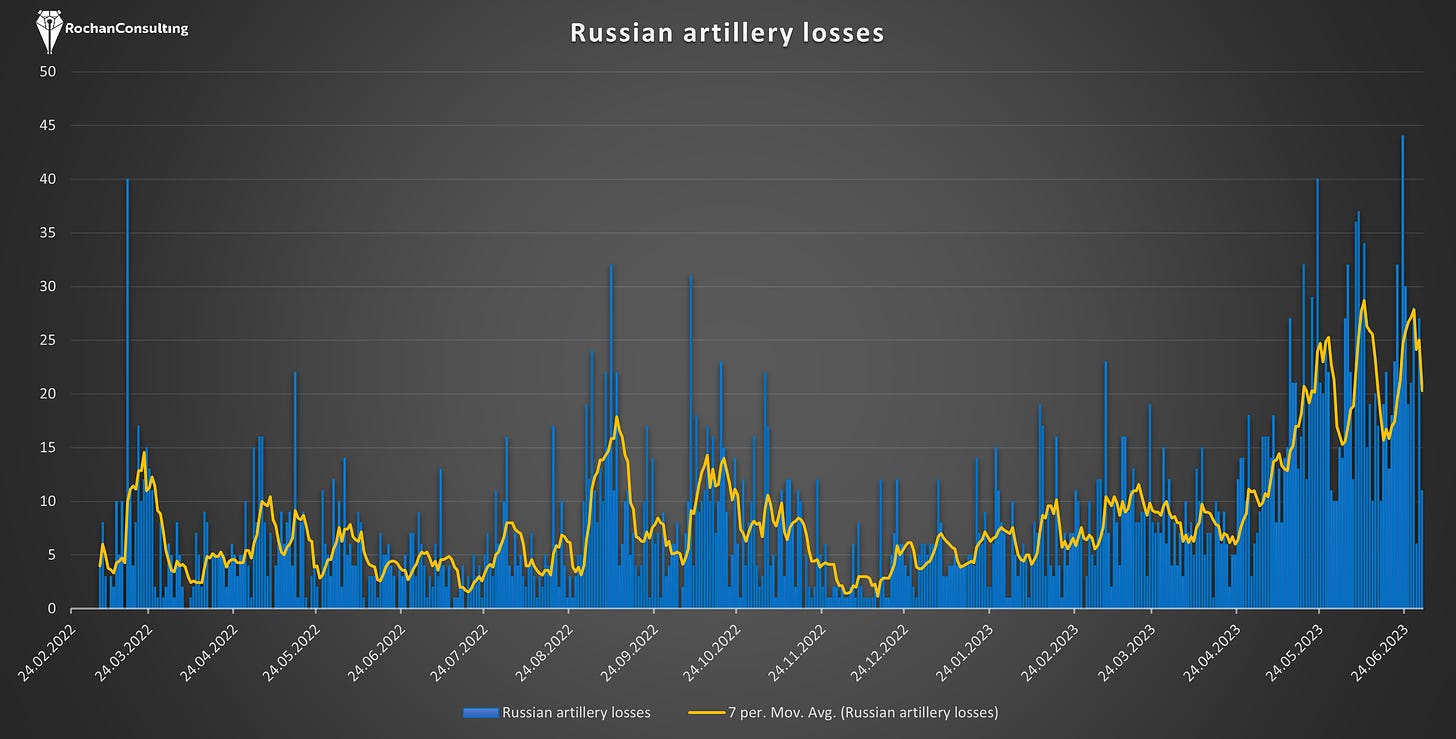
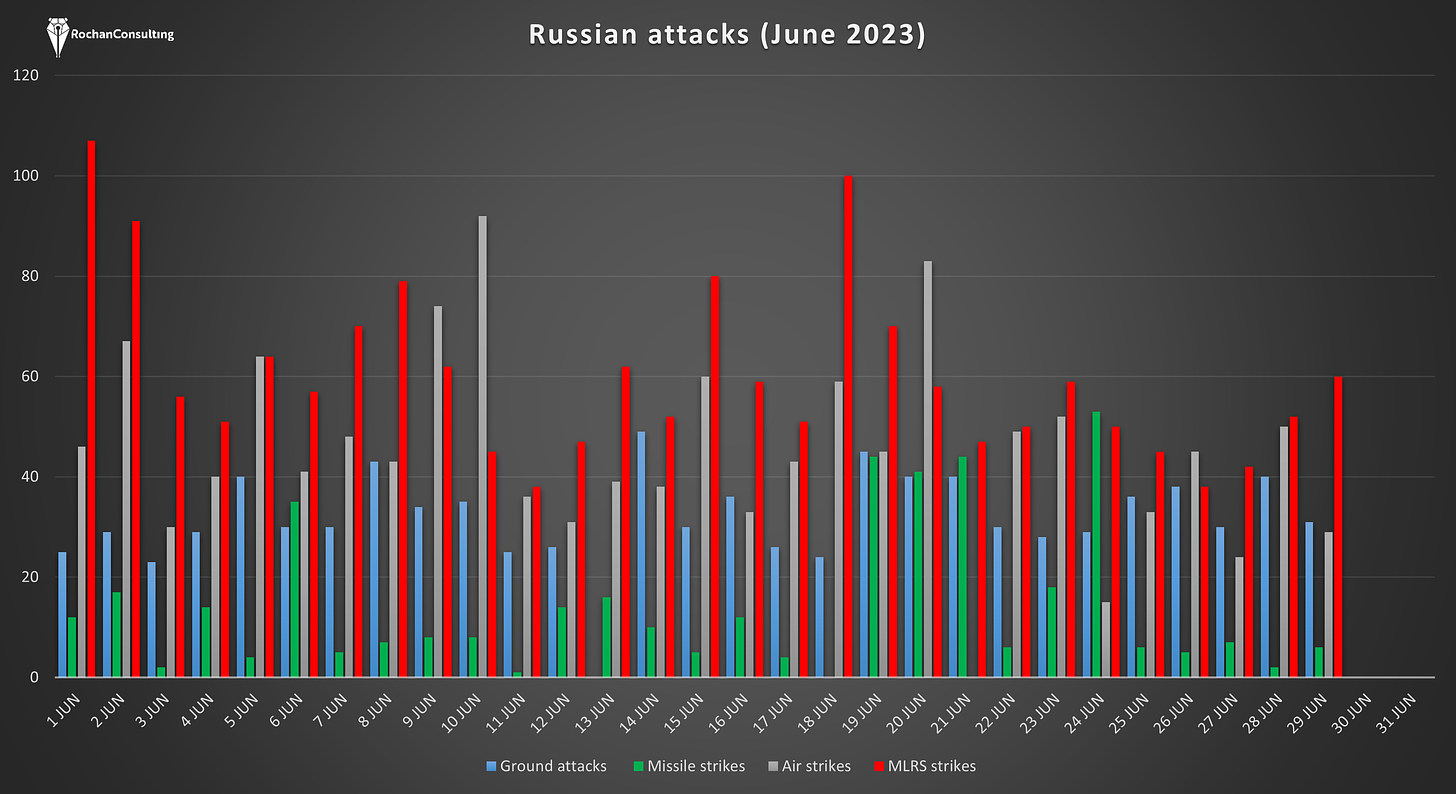
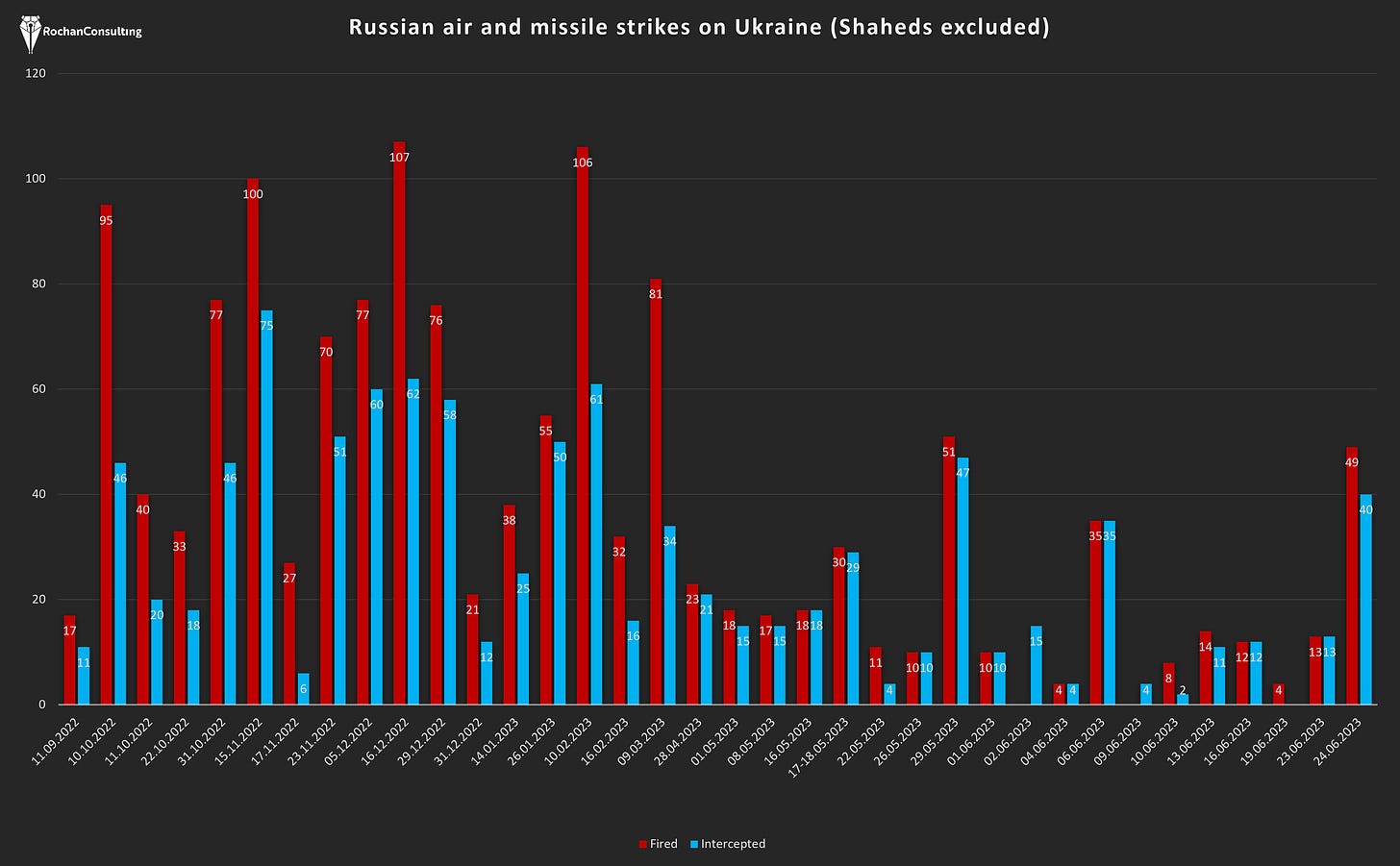
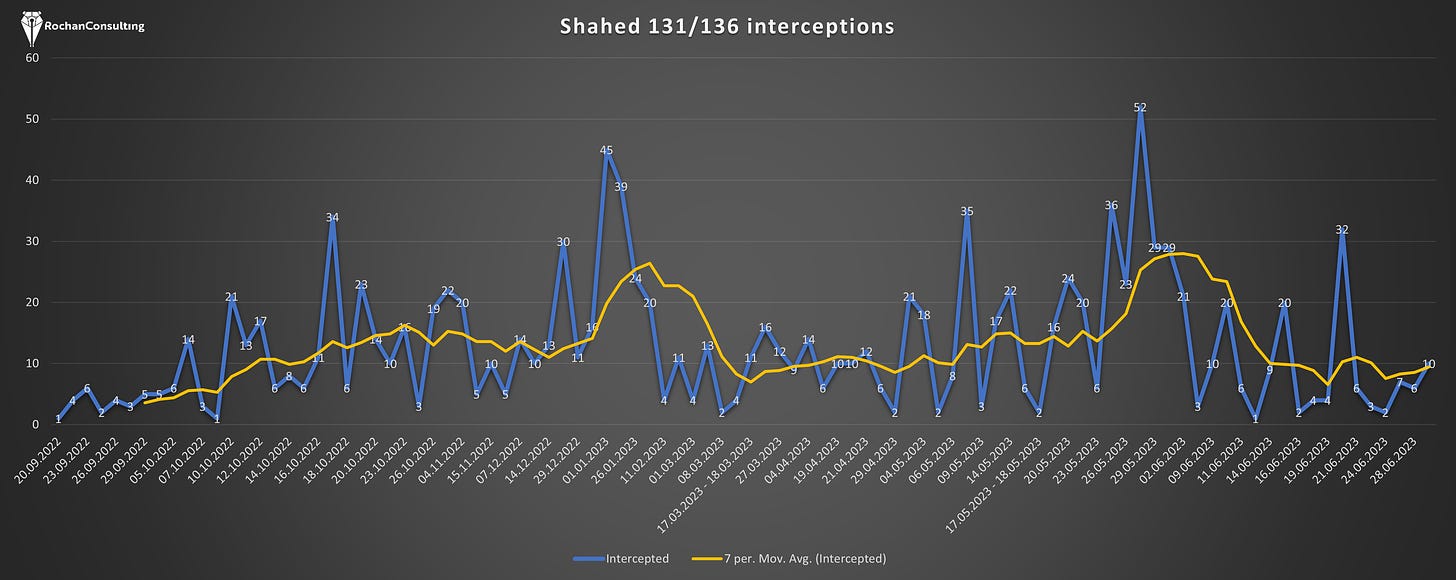

Konrad, I think you scored your prediction harshly: "unlikely they will capture more than one village next week". They only captured one village, so technically, you were correct. Only reason this should maybe be a .5 is the tone.
In your view, do you think Ukraine is actually trying to counter-attack with full force, or might they wait for additional capabilities like ATACMs, F-16s, cluster munitions, Abrams, and Polish naval missiles before doing so?
How much a barrier to an offensive is late fall/winter weather? Even with these new capabilities, would things like cutting through a mine-field be more difficult in the snow? (slash fall/early winter mud?)
Let's assume Ukraine continues to make slow gains in July. A village a week in Donetsk + Zaporizhzhia. 200-400 meters a day around Bakhmut, and say they take back Bakhmut itself. Let's say they consolidate minor gains around Antonovsky, but just as a fixing operation. And Ukraine continues to take basically unsustainable losses and use unsustainable amounts of munitions. What is the probability that they then declare victory on this offensive with Bakhmut in hand, and stop the offensive and wait for F-16s, ATACMs, etc. etc.?
" targets inside of Russia (probably Crimea excluded)," - very bad phrasing, that suggest that Crimea is part of the Russia.